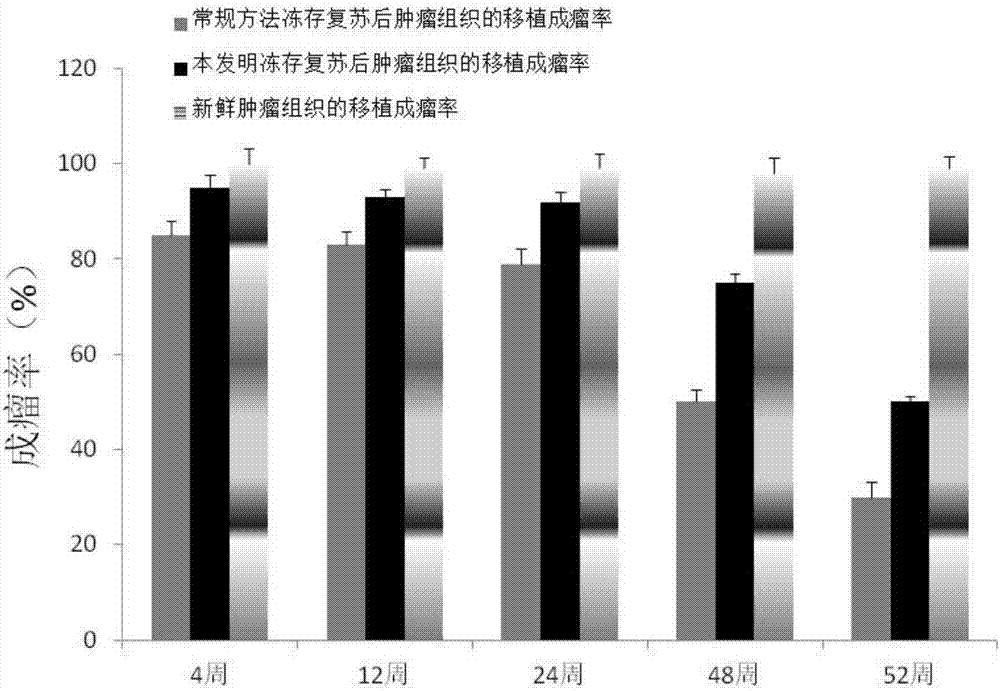Tumor tissue preservation method and preservation reagent
A technology of tumor tissue and preservation method, applied in the field of tumor tissue preservation method and preservation reagent, which can solve the problems of short shelf life, easy loss of tumor genetic characteristics, poor stability of cryopreservation solution, etc., and achieve the effect of high tumor formation rate
- Summary
- Abstract
- Description
- Claims
- Application Information
AI Technical Summary
Problems solved by technology
Method used
Image
Examples
Embodiment 1
[0038] Embodiment 1, preservation of human tumor tissue
[0039] 1. Tumor tissue preservation reagents
[0040] Tumor tissue enzymatic hydrolysis reagent: composed of hyaluronidase, DNase I and DMEM culture solution containing 10% fetal bovine serum by volume. Wherein, the concentration of the hyaluronidase in the tumor tissue enzymatic hydrolysis reagent is 120 mg / mL; the DNase I concentration in the tumor tissue enzymatic hydrolysis reagent is 100 mg / mL. It is equivalent to containing 48-120 U of the hyaluronidase per liter of the tumor tissue enzymatic hydrolysis reagent, and containing more than 40 Kunitz U of the DNase I.
[0041] Cryopreservation solution: composed of DMSO and sucrose; and in the cryopreservation solution, the concentrations of DMSO and sucrose are 1 mol / L and 0.1 mol / L respectively.
[0042] 2. Tumor tissue preservation method of the present invention
[0043] The patient's tumor tissue samples were obtained from a 56-year-old male patient with colon...
Embodiment 2
[0052] Example 2, establishment of in vivo tumor tissue bank
[0053] Mice to be tested: SCID mice (Severe combined immunodeficient mice), regardless of sex, aged 4 to 5 weeks.
[0054] 1. The tumor tissue specimens in cryopreservation in Example 1 were resuscitated in a 37° C. water bath, and then transferred to an ice-bathed DMEM medium (containing 10% fetal bovine serum by volume).
[0055] 2. Transplant the tumor tissue resuscitated in step 1 under the anterior axillary capsule of the mouse. Specifically: after the animal is anesthetized with isoflurane, disinfect the skin on the back and abdomen of the mouse, wipe it dry with a sterile cotton ball, cut a small incision near the anterior armpit on one side of the mouse with a blade, and bluntly separate the skin from the subcutaneous tissue with an 18G puncture needle. , make it into a leather bag, place the prepared tumor tissue block in it, and add a drop of double antibody (100×penicillin / streptomycin) to the incision....
Embodiment 3
[0057] Embodiment 3, the impact of different cryopreservation time on the tumor formation rate of transplanted tumor model of colon cancer
[0058] The tumor tissues of Example 1 were cryopreserved for 4-52 weeks (4, 12, 24, 48, 52 weeks) to establish a xenograft model according to the method of Example 2 (at least 5 mice were set for each cryopreservation time) ), the effects of different freezing periods on the tumor formation rate of colon cancer xenograft models were counted 4 weeks after transplantation into the tumor tissue.
[0059] At the same time, the fresh tumor tissue in Example 1 without freezing was set as a control.
[0060] The result is as figure 1 shown. It can be seen from the figure: after adopting the cryopreservation method of the present invention to resuscitate the tumor tissue, transplant it to the immunodeficiency mouse, and compare it with the mouse transplanted with fresh tumor tissue within 24 weeks after transplantation, the transplantation succ...
PUM
 Login to View More
Login to View More Abstract
Description
Claims
Application Information
 Login to View More
Login to View More - R&D
- Intellectual Property
- Life Sciences
- Materials
- Tech Scout
- Unparalleled Data Quality
- Higher Quality Content
- 60% Fewer Hallucinations
Browse by: Latest US Patents, China's latest patents, Technical Efficacy Thesaurus, Application Domain, Technology Topic, Popular Technical Reports.
© 2025 PatSnap. All rights reserved.Legal|Privacy policy|Modern Slavery Act Transparency Statement|Sitemap|About US| Contact US: help@patsnap.com


